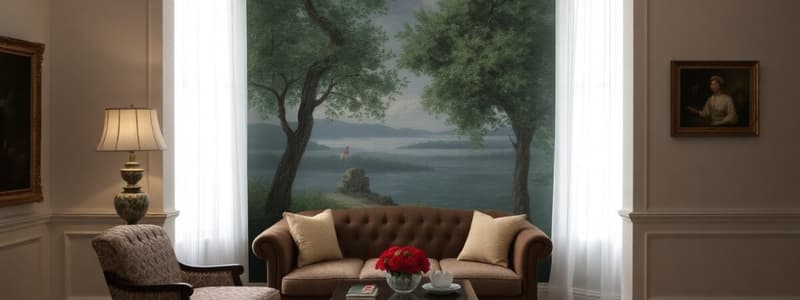Podcast
Questions and Answers
Which characteristic is NOT associated with traditional design?
Which characteristic is NOT associated with traditional design?
- Antique furniture
- Sleek clean lines (correct)
- Patterned oriental rugs
- Color palette with jewel tones
What best describes contemporary design's color palette?
What best describes contemporary design's color palette?
- Whites, blacks, and greys with pops of color (correct)
- Bright and diverse colors
- Warm neutrals and pastels
- Dark stained woods and jewel tones
Which of the following is NOT a printed textile pattern found in traditional design?
Which of the following is NOT a printed textile pattern found in traditional design?
- Checks
- Geometric (correct)
- Plaids
- Floral
What is a key feature of eclectic design?
What is a key feature of eclectic design?
Which design style combines elements of traditional and contemporary styles?
Which design style combines elements of traditional and contemporary styles?
In contemporary design, what type of materials are commonly used?
In contemporary design, what type of materials are commonly used?
What describes the feel of cottage design?
What describes the feel of cottage design?
Which option does NOT represent a characteristic of transitional design?
Which option does NOT represent a characteristic of transitional design?
Flashcards
Traditional Design Style
Traditional Design Style
Characterized by dark stained woods like cherry, mahogany, and oak, antique furniture, and rich jewel tones or historic colors like Williamsburg blues and yellows. Textiles often feature traditional patterns like checks, plaids, florals, and toiles, along with trims and cording. Oriental rugs with jewel tones and wood floors are common elements.
Transitional Design Style
Transitional Design Style
A design style that blends modern and contemporary elements with traditional features, creating a balance between sleek lines and warmer, more classic elements.
Contemporary Design Style
Contemporary Design Style
Known for its sleek, clean lines, minimalist approach, and a focus on functionality. It often incorporates metals and glass accessories, leather furniture, and a color palette of whites, blacks, and grays with pops of color.
Eclectic Design Style
Eclectic Design Style
Signup and view all the flashcards
Cottage Design Style
Cottage Design Style
Signup and view all the flashcards
Study Notes
Design Styles
-
Traditional:
- Features dark stained wood like cherry, mahogany, and oak.
- Furniture is often antique.
- Color palettes are jewel tones or historic colors (e.g., Williamsburg blues and yellows).
- Textiles include checks, plaids, florals, and toiles.
- Often features patterned oriental rugs with jewel tones.
- Wood floors are common.
- Gives off a museum-like atmosphere.
-
Eclectic:
- Mixes elements from different time periods.
- Color palettes vary.
-
Contemporary:
- Characterized by sleek clean lines.
- Accessories include metals and glass.
- Furniture often features leather and unusual styles.
- Color palettes often include whites, blacks, and greys, with pops of color.
- Reflects a minimalist aesthetic.
- Materials used are a combination of natural and manufactured materials.
- Represents present-day design.
-
Modern:
- Originated in the early 20th century.
- Features warm neutral colors.
- Characterized by clean and strong lines.
-
Cottage:
- Offers a casual feel.
- Emphasizes overstuffed furniture.
- Commonly features whites, off-whites, and shabby chic styles.
- Mixes natural elements with worn or aged painted furniture.
- Utilizes mixed metals with burnished colors, matte, and brushed finishes.
-
Transitional:
- Combines traditional and contemporary elements.
- Has contemporary twists within a traditional framework, giving a "more funky" or "modern" feel.
- Includes white, dark stains, and bright accents.
- Involves contemporary artwork.
- Utilizes sleek lines on furniture but with a warmer feel compared to straight contemporary design.
- Accessories are a mixture of traditional and contemporary elements.
- Often uses golds and other polished metals with matte finishes.
-
Other Styles:
- Additional styles include Rustic, Zen, Steampunk, Coastal, Hacienda, and Shabby Chic and Postmodern.
Studying That Suits You
Use AI to generate personalized quizzes and flashcards to suit your learning preferences.




